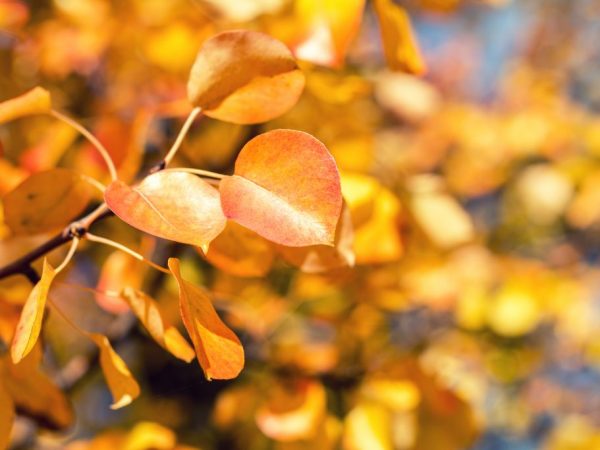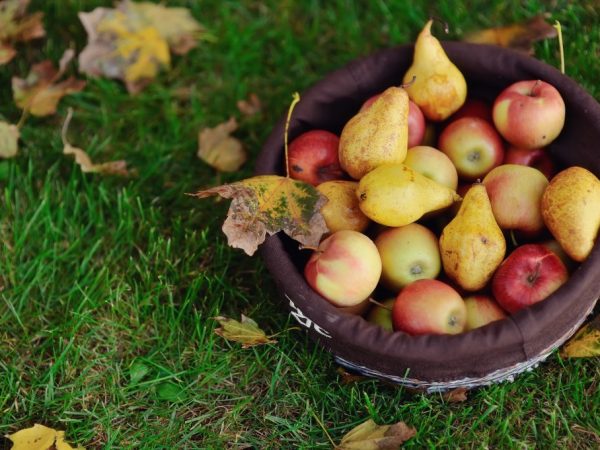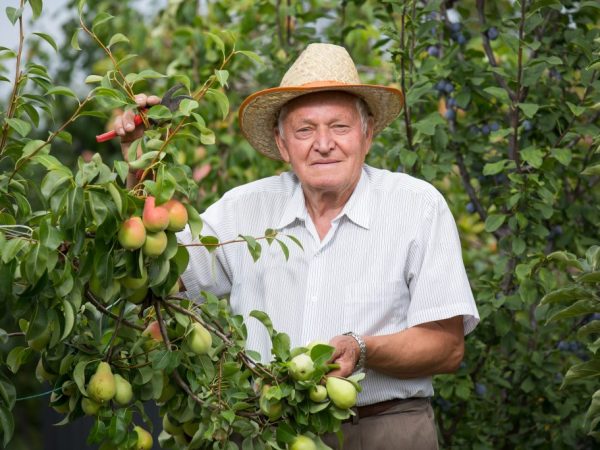Features of planting pears in the fall
Planting a pear in the fall according to the rules and optimal care for it ensure rapid growth and a bountiful harvest already for 2-3 years.

Features of planting pears in the fall
Variety selection
For northern latitudes, the following are suitable:
- Cathedral;
- Otradnenskaya;
- Severyanka;
- Fields.
They can withstand the cold of the Khabarovsk Territory, Buryatia, and the Irkutsk Region.
For the middle latitudes of Russia and Ukraine, the following are suitable:
- Lada;
- Lumpy;
- Chizhevskaya;
- Tenderness;
- Muscovite;
- Fabulous.
They are the easiest to adapt to cold winters and hot summers.
Among the southern varieties are chosen:
- Dicolor;
- Ilyinka;
- Swallow;
- Rosie Red Bartlett;
- Melting.
The shelf life of these fruits is 200-250 days.
Sapling selection
A seedling of any variety must be 1-2 years old. Overgrown powerful seedlings are not suitable. They do not take root well during transplantation.
The plant is carefully examined. It should be strong, elastic, intact, with or without healthy branches up to 30 cm long. Diameter - no more than 15 mm. The trunk and branches are of a uniform color. Blotches and stains indicate the presence of diseases.
The root system should be dense and well-formed. Roots - no rot or other damage. Their length is more than 30 cm.
Before planting, all leaves are removed from the seedling. They require moisture and nutrients from the roots that are not yet developed. The dried roots of the additive are soaked in water for a day.
Site and soil preparation

The pear should grow in a spacious place
It is better to immediately correctly determine the permanent place for the pear, because it does not tolerate transplanting well. You can transplant a fruit to a new location only once.
The place is chosen at a distance of more than 3 m from houses and buildings. The south, southwest side of the garden will do without drafts. The place should be sunny, but not hot, on a slope or a hill. It is better to transplant other plants at a distance of 5 m.
Most garden pears have a wide crown and an average height of 10-15 m. This is taken into account when choosing a place.
Sandy or gravelly soil is required. Gray forest soil is also used. A waterlogged one with drainage is suitable. Groundwater should lie far from the soil surface, otherwise the pear roots will be in the water after 3-4 years and rot.
Pits are dug several months before planting. A distance of 3-6 m is maintained between them. Step-by-step instructions for preparing pits:
- The indentations are made with a diameter of 80 cm. Their depth is 50 cm for 1-year-old seedlings and 60 cm for 2-year-old ones.
- Fertilizers are applied to the bottom of the pit. If the soil is sandy, after fertilization, add half a bucket of clay or peat mixture. The substances help to retain moisture.
- A ¼ pit is covered with black soil. The roots will not come into contact with fertilizers, so they will not get burned.
Landing
Basically, the pear is planted in the fall, in September-early October, before the first frost.
Just before planting, the roots of the pear are pruned a little. 1-year-old seedlings are pruned with 2 mm of roots. 2-year-olds - 3-4 mm of roots. The procedure improves the absorption capacity of the roots.
Planting a pear correctly in the fall helps the planting guide:
- 25-30 cm recede from the center of the pit.A wooden stake is driven in up to the first branch of the seedling. A hill is formed around it.
- A mixture of soil with fertilizers is poured into the pit. Form a hill inside the pit.
- A tree is planted on a mound on the north side of the peg, tied to a stake. The root collar should be 5-6 cm above ground level.
- All roots are straightened. They are covered with soil with fertilizers. The soil is well tamped and trampled down.
- A hole is formed. The seedling is abundantly watered with 5-6 liters of water.
The pear is planted tightly. When properly seated, it cannot be pulled out. If the soil subsides, the soil is poured over.
Strict adherence to the instructions helps the root system of the additive to adapt as quickly as possible to a new place.
Care

A good pear with good care
After planting in the fall, the pear needs careful care, incl. to prepare for the first wintering.
All dried and damaged branches are cut off. They will not sprout in the spring. Only skeletal branches are left. Pruning is carried out before frost, so that the slices have time to heal. Healthy branches are tied with a rope in a bundle to protect them from wind and snow. Pruning is carried out with a knife or pruning shears, cut with a quick movement at a right angle.
If the fall is dry, the plants are watered abundantly. Lack of water reduces the pear's resistance to severe frosts and temperature changes. The fallen snow is thrown into the trunk circle. This helps the soil with roots not to freeze in severe frosts.
Fertilizers
To plant a pear tree in the fall, the first time the soil is fertilized when preparing the pit. Ammonia fertilizers, superphosphate are applied to the bottom: 2 kg of the mixture per 1 pit. Organic humus is introduced in a limited amount: a bucket in a pit.
When preparing a tree for wintering, nitrogen fertilizers are not used. They provoke the growth of young shoots, vulnerable even to mild frosts.
To increase frost resistance in the fall, fertilizers from potassium and phosphorus are applied under the tree. Dig out several holes 20 cm deep. Into each one add 1 tbsp. l. potassium sulfate and 1 tbsp. l. superphosphate. Pour water on top and bury it.
Immediately after planting, mulch is introduced: manure, grass, humus - and leave it for the whole autumn. Before wintering, organic mulch is changed to another. Straw is not used, because mice settle in it.
Treatment
The tree's resistance to adverse weather conditions and diseases is increased by spraying pears with Zircon or Ecoberin. A spraying procedure is carried out from the scab of the trunk and branches. It is safe to use a 5% urea solution.
The bark is treated for growths, wounds formed during the fall. They are cleaned, washed. For processing, copper sulfate is first used, then garden var.
To protect against insect pests, causative agents of fungal diseases, spray the bark and the upper part of the soil with 1% Bordeaux liquid, Nitrafen.
Pear diseases
- Scab. A symptom is the presence of putrid cracked spots on the leaves. The varieties Muratovskaya, Yanvarskaya, Rusanovskaya are relatively resistant to it. Spray with 1% Bordeaux liquid and fungicide "Skor".
- Moniliosis. Sign - brown spots with gray growths on the leaves. The leaves are rubbed with lime milk. It is prepared with water in a ratio of 1:10.
- Sooty fungus. Sign - blackened leaves and shoots of young seedlings. Fitoverm is used.
- Powdery mildew. Sign - white bloom on the leaves. The tree is sprayed with Fundazol, soda ash and liquid soap in an amount of 50 g per 10 liters of water.
Pests
A dangerous pest is a pear leaf flap or a honeydew. It is a yellowish or gray insect up to 3 mm long. It sucks the juices from the branches, leaves, which are covered with a transparent liquid. Spraying with Aktara insecticide helps.
The pear gall mite infects the leaves of the plant. Swellings of brown and black colors appear on them. It is fought with mitak acaricide and colloidal sulfur.
The winter moth affects shoots, buds, and leaves. She hibernates in cocoons in the soil.Dig up or replant soil effectively before frost.
Rodents cause trouble. Hares and mice gnaw on young bark and wood. For prophylaxis, the trunk is wrapped in burlap, plastic mesh or spruce branches. The bark of the trunk is coated with clay with a mullein in a 1: 1 ratio, diluted with water to the consistency of sour cream. The solution has a strong unpleasant smell and taste, which scares off rodents.
Conclusion
Before planting in spring, autumn has some advantages. Heat-loving plants take root better in autumn, moist, not yet frozen soil. The cold spring earth provokes the death of plantings.
There is only one drawback: the bark of a young pear has not yet matured, therefore it is eaten by rodents. Some varieties freeze in severe frosts. Timely preventive measures help the young tree overwinter.


